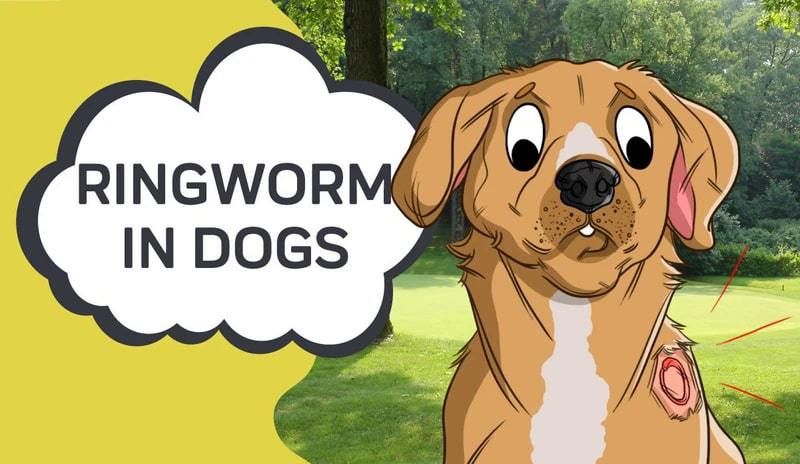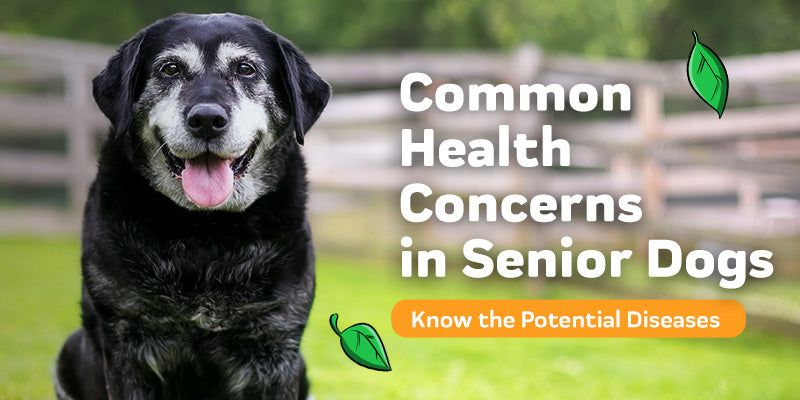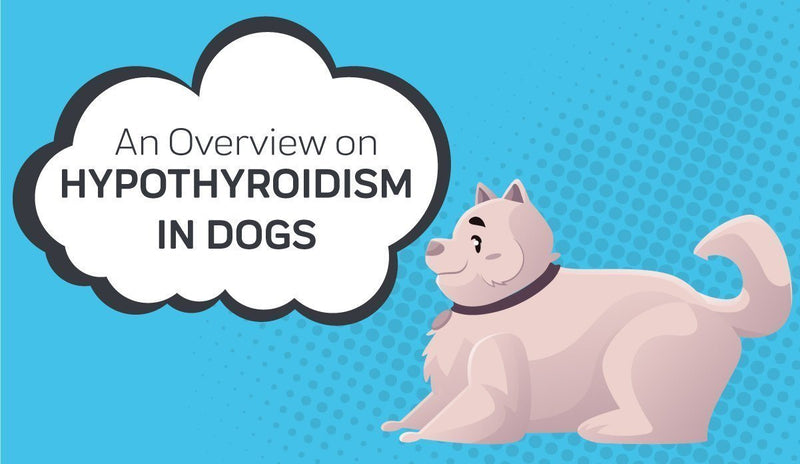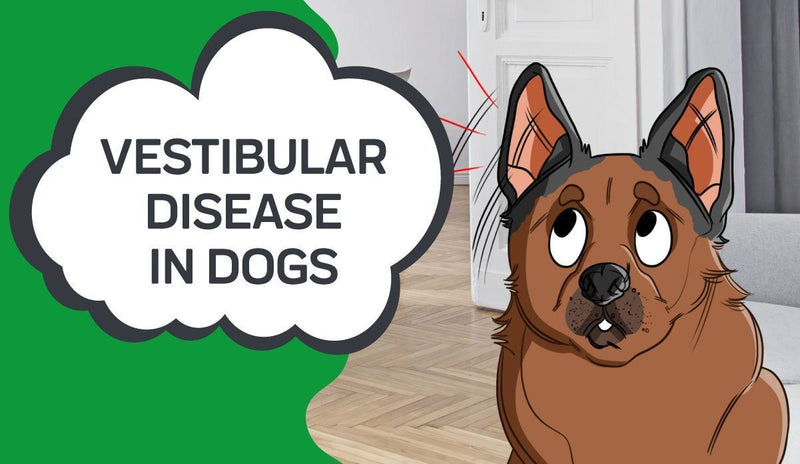- Dermatophytosis in Dogs: What is Ringworm?
- Symptoms of Ringworm Infection in Dogs
- Can Ringworm Pass from One Dog to Another?
- How Contagious is Ringworm in Canines?
- Five Fun Facts That You Might Not Know about Ringworm in Dogs and Cats
- How to Relieve Your Dog of a Ringworm Infection at Home
- Ringworm Treatment Options
- CBD for Ringworm in Animals
 Ringworm is a condition that usually does not resolve itself, so medical attention from a professional is needed to relieve the problem. Ringworm is caused by the build-up of fungus in certain ways, and it takes the shape of a circle or a ring. The skin condition is not often a filled-in circle, though it can be in more severe cases.
Ringworm is a condition that usually does not resolve itself, so medical attention from a professional is needed to relieve the problem. Ringworm is caused by the build-up of fungus in certain ways, and it takes the shape of a circle or a ring. The skin condition is not often a filled-in circle, though it can be in more severe cases.
Most commonly, ringworm presents as a red outline, which is the worm part of the name. It really truly does look like a worm curled up into a circle. Don't let the name of the skin infection fool you, though. There aren't any real worms involved. Rather, the name ringworm came about because of the way the rash looks on the skin.
Dermatophytosis in Dogs: What is Ringworm?
Another term for ringworm is dermatophytosis. The fungus that causes ringworm feeds off of keratin. As a protein naturally found in skin, keratin is most densely located in nails, at the origin of hair follicles, and in skin. For this reason, ringworm most often presents itself in these parts of the body.
Ringworm is also very commonly found in places that hair, nails, or infected skin come in contact with, such as a leg that is scratched by a ringworm-affected fingernail or parts of the back that are often touched by hair stemming from scalp ringworm.
Can Dogs Get Ringworm?
Now that we know the background information on ringworm, let’s focus on how ringworm can potentially affect your dog. For starters, can dogs get ringworm? The short answer is yes, dogs are susceptible to ringworm.
Do Cats Have Ringworm, Too?
Just like dogs, cats can get ringworm very easily. In fact, there is nothing stopping a cat from getting a diagnosis of ringworm after coming in contact with a dog that has the same skin condition. Ringworm is not specific to one species, and the idea that dogs can only contract ringworm from other dogs is not true. The same goes for cats. Felines are capable of coming down with a case of ringworm after playing with an infected dog, and the same goes for healthy dogs and infected cats.
Symptoms of Ringworm Infection in Dogs
The symptoms of ringworm are not terribly hard to spot, but if you don’t know what to look for, you might not even recognize the symptoms as being signs of ringworm in dogs.
A few symptoms of ringworm in dogs include:

Alopecia on faces and paws
- Seborrhea sicca
- Scaly skin
- Odd changes to the surface of the skin
- Hair follicles that are clearly inflamed and reddened
- Infections at the root of hair follicles
- Hair loss
Can Ringworm Pass from One Dog to Another?
Ringworm thrives in warmer temperatures, and this doesn't only apply to the weather conditions in your area. It can also relate to warmer parts of your body, like your legs when wearing pants or underneath your arms. For dogs and cats, the warmer parts of their bodies tend to be their underbellies and near their joints, as well as around the neck, especially if they wear a collar.
Ringworm spreads through direct contact very quickly, and there aren't many limitations when it comes to what can and cannot be affected by ringworm.
The eight main instances where ringworm will spread from one person, place, animal, or object to another are:
- Infected Person to person
- Infected Animal to animal
- Infected Person to animal
- Infected Animal to person
- Infected Object to person
- Infected Object to animal
- Environment to person
- Environment to animal
How Contagious is Ringworm in Canines?
Ringworm from dog to person, environment, or another pet is a very common occurrence. The reason for such rapid and easy transmission of ringworm from one person, place, animal, or object to the next is due to the contagiousness of ringworm and how easy it is for transmission when you come in contact with an infected person, animal or object. Ringworm remains contagious until the moment it disappears, so please do not think that the treatment process automatically makes your pet all better. You should still keep your dog away from other canines, felines, and people until every bit of ringworm fungal infection is gone.
It's important to gently wash your dog's skin and fur when they have ringworm, but it's even more important that you don't leave the area damp. Pat the infected space using a soft towel until it is dry. Leaving behind traces of moisture will contribute to the ringworm problem rather than lessen the severity. Damp surfaces in warm environments never result in anything beneficial, and that fact remains true in the case of dogs with ringworm.
Do your best to keep the infected area exposed to the open air, if possible, but if that poses more of a risk, then a clean bandage, wrap, or any sort of covering can help protect your dog's skin until the ringworm issue is fully healed. Also, another tip for treating dogs with ringworm is to treat other parts of the body that often come in contact with the infected region. For example, let's say the back of your dog's neck is the location of ringworm.
Try to walk yourself through the motions your dog makes throughout the day and figure out what other parts of your dog's body touches the back of his or her neck daily. Your dog likely scratches the back of their neck with a back foot or front paw. Even if your dog's paws do not show signs of the presence of ringworm, they could potentially still have very miniscule traces of keratin embedded between the hair or skin, toes, pads, or claws.
In order to keep your dog's feet from making the ringworm on their neck that much worse, treat your dog's feet the same way you do the ringworm on their neck. That way, it's impossible for ringworm to travel from feet to neck, or from neck to feet, because you are covering all the bases by treating both locations. On a related note, your dog is less likely to transmit the skin condition to other dogs, cats, or people because you are making sure to fight ringworm at every possible spot.
Other attributes that heighten the risk of ringworm include...
- Weak immune systems by nature
- Diseases that weaken the immune system
- Close proximity to a person or animal that already has ringworm
- Warm, muggy, and humid environments
- Brushing against fungus on common and shared items
Five Fun Facts That You Might Not Know about Ringworm in Dogs and Cats
- There is more than one type of ringworm, and certain variations of the skin condition are more likely to affect one type of animal over others. For example, there is a variation of ringworm called the Microsporum canis. This ringworm type is far more likely to infect cats than any other animal. This is not to say that humans and dogs are incapable of contracting Microsporum canis, but the likelihood of that happening is far more probable for felines.
- Ringworm can sometimes be mistaken for a simple bout of itchy skin, and that is the leading cause behind ringworm that goes untreated for such a long period of time. Dogs and cats scratch themselves every single day, so it isn't out of the ordinary for your pet to itch their skin. However, the itchy skin is likely pruritus, which indicates the presence of ringworm, so keep an eye out for excessive scratching.
- Some breeds are more likely to experience ringworm at some point in their lives for no reason other than the fact that they are dispositioned to ringworm. Two cat breeds that have a higher risk of ringworm infections are Persian cats and Norwegian Forest cats, both of which have long hair. The more hair, the better the environment for ringworm to thrive.
- The top four leading factors of ringworm for dogs are age, humidity levels in the area, hyper cleanliness, and a lack of important nutrients.
- Animals with weakened or otherwise suppressed immune systems are at a greater risk of contracting ringworm from their environment. Their bodies do not have the defenses necessary to fight off ringworm, and thus, the fungus makes a home out of the young and underdeveloped animals' skin.
How to Relieve Your Dog of a Ringworm Infection at Home
While you should certainly take your dog to the vet so that your canine companion can be evaluated by a professional, the great news about ringworm in dogs is that it can be relieved from the comfort of your home.
Your dog’s veterinarian will likely request that you schedule a follow-up appointment just to make sure the treatment is working and your dog is on the path to healing. But for the most part, the treatment of dog ringworm just requires that you stay consistent with the treatment method your dog’s vet prescribes.
Ringworm Treatment Options
There are three major ways to treat ringworm in dogs, and all of them can be supplemented with cannabidiol. We will dive into the benefits of CBD for ringworm shortly, but first, here are the three most common ways of ringworm treatment for dogs.
Medication for Ringworm
Another common treatment of ringworm for dogs involves oral medication. In more serious cases of dog ringworm, veterinarians look into systemic treatment options for dogs. While topical treatments are noninvasive, this medicinal treatment of ringworm requires that your pet swallow a pill or a capsule.
There are three widely recommended forms of systemic treatment of ringworm for dogs.
These three medications are:
- Griseofulvin
- Itraconazole
- Ketoconazole
Griseofulvin is not for puppies under the age of six weeks old, and this fact brings up an important point. Some medicinal remedies for ringworm have very potent ingredients that the bodies of both young pups and old dogs cannot withstand. While Griseofulvin is on par with a miracle worker for ringworm in dogs, it is not a medication that should ever be administered to cats. It reacts in a fatal way with cats, and in the worst-case scenario, a cat that consumes Griseofulvin is likely to end up with blood disorders and dysfunction.
Itraconazole is perfectly safe for both cats and dogs. The list of potential side effects resulting from Itraconazole is very slim, with the three symptoms being constant nausea, persistent diarrhea, or rapid weight loss as a result of little to no appetite. That said, side effects are very rare and Itraconazole is the least likely to upset your pet during the recovery process.
Ketoconazole works fairly well, though it is not always a 100% effective treatment of ringworm in dogs, nor is it easy on the stomach of canines. Make another note that this medication is not a systemic treatment option for cats with ringworm. The potency is far too intense for cats to handle, and there are endless worrisome side effects that are beyond safety measures for cats. Ketoconazole is used in very desperate situations for very dire cases of dog ringworm, so this is not a remedy that you reach for if there are other options available.
Topical Ointments for Dog and Cat Ringworms
Applying ointments to the external part of the infected skin is a method of treatment that has proven to be quite effective. Before you apply topical treatments to your dog's infected skin, your veterinarian will emphasize the importance of getting your dog's fur clipped. By doing so, you will ensure that the location of your dog's ringworm will be clear of further contamination. Since ringworm is caused by excessive keratin, clipping back the fur in the vicinity of the ringworm will prevent the possibility of additional keratin touching the skin and making the problem worse.
After following through with the clipping process, it is then possible to start applying topical treatment to the area. There are a few different options when it comes to the type of topical applications that work as remedies for ringworm in dogs. An antifungal is the most applicable type of topical medication because its intended purpose is to fight and kill fungus infections.
For dogs ringworm, an antifungal treatment called a lime-sulfur dip is a very common prescription given out by veterinarians. Another route that your vet might take is to suggest that your dog receive regular baths using a shampoo that is specifically designed to fend off the fungus and relieve ringworm in dogs. These shampoos often contain a combination of chlorhexidine and miconazole, which are chemicals proven to work wonders when seeking relief from ringworm.
Adjusting the Environment to Combat Ringworm
Your dog’s environment plays a part in whether or not the ringworm is treated, healed, and eventually eradicated from your dog’s skin. We do not always realize just how important and impactful our environments are, but this does not diminish its influence on our health. Changing the environment so that your dog is not exposed to the contributing factors of the skin condition is the third method of ringworm treatment for dogs.
CBD for Ringworm in Animals
CBD can act as a supplement and make the healing process more bearable for dogs with ringworm. As a substance that is derived from the cannabis plant, cannabidiol is an incredible pain reliever. CBD can be extracted from both hemp plants and marijuana plants, and the origin of the cannabidiol is what dictates the THC content of the CBD oils.
Now, in order for a product to be on the market as a CBD product, it cannot contain more than 0.03% of THC. This is the limit that is set because cannabidiol with more than 0.03% of a THC concentration will produce psychoactive effects, which happen to be the number one deterrent for people who do not want to give CBD to their pets.
We understand, too. It can be nerve-wracking and daunting to think about giving CBD to your pets, especially if you think of CBD as weed or mind-altering. It’s important to understand that even though CBD stems from cannabis and hemp plants, CBD does not induce the same behaviors, mindset changes, or effects on the body as THC.
Cannabis is not the culprit that is responsible for the feeling of being high. Instead, THC creates these perceptual changes and sensations. And even when CBD has a slight concentration of THC, the CBD products are incapable of getting you or your pets high. It’s scientifically not possible. If you there is still a little bit of worry in your mind when you think about giving even the slightest amount of THC to your pet for ringworm in dogs, that’s okay! It doesn’t take CBD off the table for your pet, either. There are two forms of CBD, one of them being full-spectrum CBD and the other being CBD isolates.
Full-spectrum CBD is a category of CBD that does contain very minimal percentages of THC per serving of CBD. But CBD isolates are completely void of any and all THC. They are the purest form of cannabidiol, and they are the better option for pet owners who feel nervous about THC in their pet’s CBD products.
Now, you might be wondering why anyone would willingly opt for full-spectrum CBD for pets when CBD isolates exist. That is a very valid point, and the answer to the question has a lot to do with a phenomenon known as the entourage effect. The trace amounts of THC amplify the effects of the CBD slightly more than CBD can achieve on its own.
Innovet has an array of CBD products for dogs with ringworm. CBD can help alleviate pain, calm nervous dogs, and give your puppy some relief while dealing with the side effects of this skin condition. CBD is great to pair with systemic and topical treatment methods as well because the CBD will combat any negative side effects that these medicinal remedies cause. Check out Innovet’s CBD inventory today!
Sources:
Ringworm (Dermatophytosis) in Dogs
Ringworm - Signs, Diagnosis, and Treatment
The Role of Cannabinoids in Dermatology
Approved by:
Dr. Ivana Vukasinovic
Doctor of Veterinary Medicine, University of Belgrade
 Ivana Vukasinovic grew up in Serbia and attended the University of Belgrade where she received a degree in Veterinary medicine in 2012 and later completed surgical residency working mostly with livestock. Her first year of practice was split between busy small animal practice and emergency clinic, and after two more years of treating many different species of animals, she opened her own veterinary pharmacy where an interest in canine and feline nutrition emerged with an accent on fighting animal obesity. In her free time, she acts as a foster parent for stray animals before their adoption, likes to read SF books and making salted caramel cookies.
Ivana Vukasinovic grew up in Serbia and attended the University of Belgrade where she received a degree in Veterinary medicine in 2012 and later completed surgical residency working mostly with livestock. Her first year of practice was split between busy small animal practice and emergency clinic, and after two more years of treating many different species of animals, she opened her own veterinary pharmacy where an interest in canine and feline nutrition emerged with an accent on fighting animal obesity. In her free time, she acts as a foster parent for stray animals before their adoption, likes to read SF books and making salted caramel cookies.
Thanks for stopping by!
P.S. We Love You!
Sincerely,
The Innovet Team
Please do not ask for emergency or specific medical questions about your pets in the comments. Innovet Pet Products is unable to provide you with specific medical advice or counseling. A detailed physical exam, patient history, and an established veterinarian are required to provide specific medical advice. If you are worried that your pet requires emergency attention or if you have specific medical questions related to your pet’s current or chronic health conditions, please contact or visit your local/preferred veterinarian, an animal-specific poison control hotline, or your local emergency veterinary care center.
Please share your experiences and stories, your opinions and feedback about this blog, or what you've learned that you'd like to share with others.

















